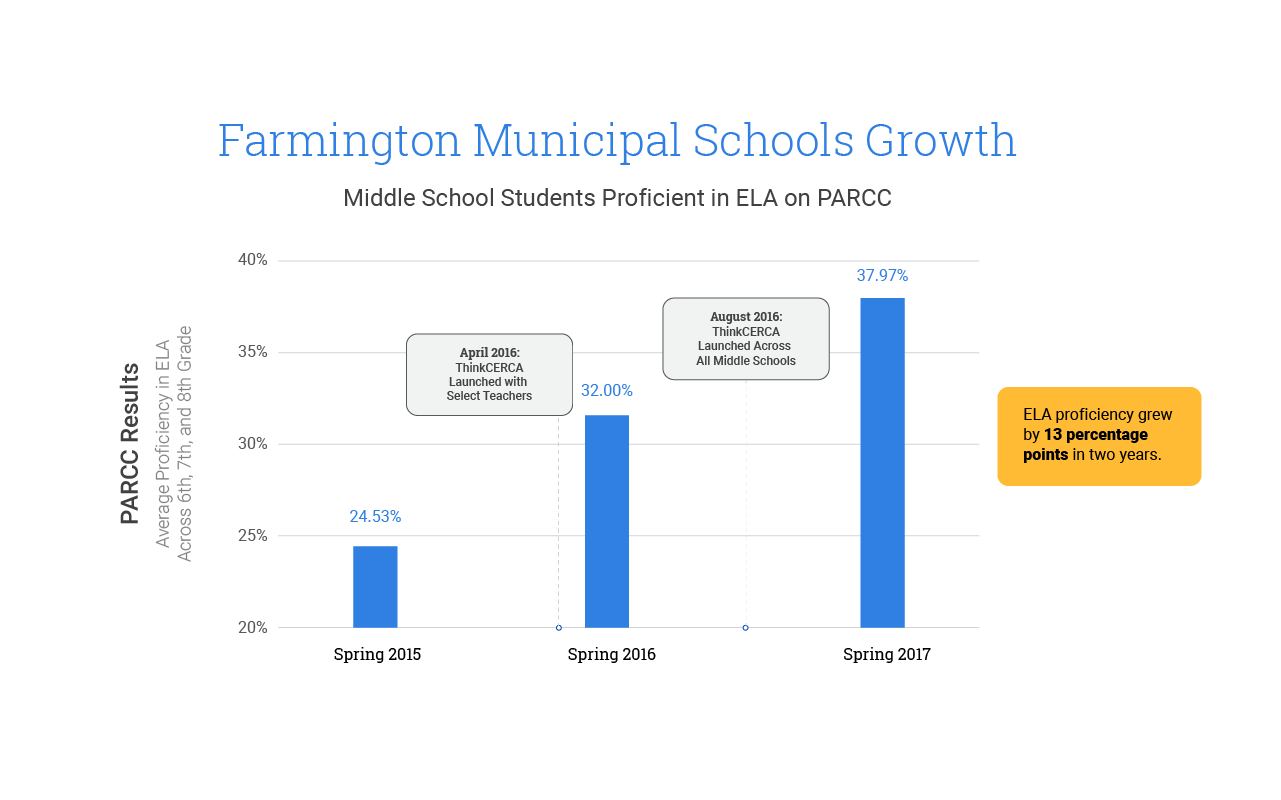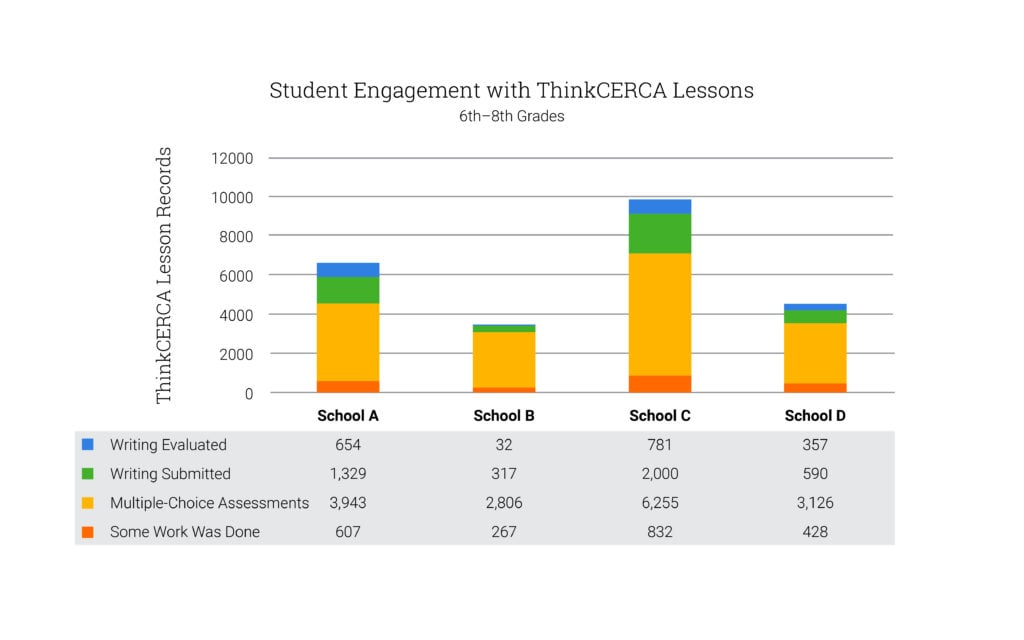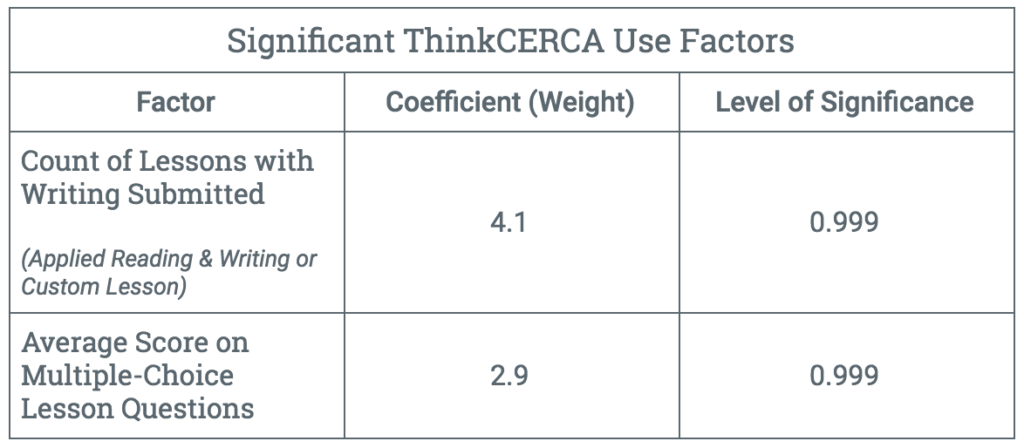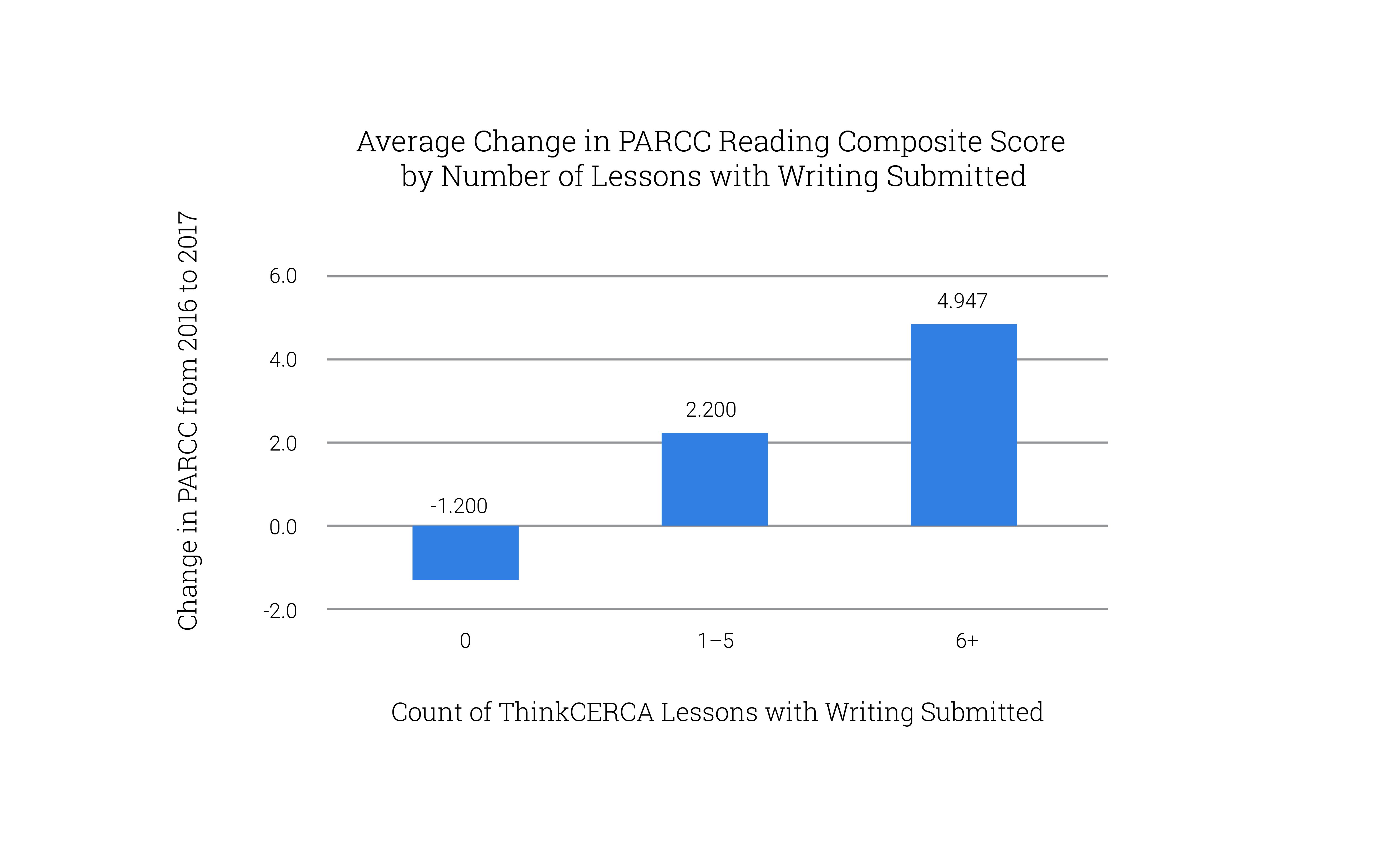Case Study
Achieving Double-Digit PARCC Growth Through Argumentative Writing
How Farmington Municipal Schools established itself as one of New Mexico’s top performing districts with ThinkCERCA.

Key Takeaways
- The number of Farmington middle school students considered proficient in ELA, as measured by PARCC, increased by 13 percentage points in two years.
- Students who submitted six or more ThinkCERCA writing lessons saw an increase of nearly 5 points in their PARCC scores, while those who submitted 1 to 5 lessons saw only 2.2 points. Those who submitted no lessons saw a decline of 1.2.
- The researchers found a statistically significant connection between students who received feedback on their writing and an increase in PARCC writing subtest scores.
Download the Case Study
The Challenge
In today’s world, the ability to consume information, think about it critically, and express one’s thoughts effectively is becoming increasingly more important. And with the adoption of more rigorous standards and assessments all across the nation, many districts are acknowledging writing—specifically argumentative writing—as the key to critical thinking and career- and college-readiness.
One such district is Farmington Municipal Schools in New Mexico.
In 2015, only roughly a quarter of the district’s 6th-, 7th-, and 8th-grade students were considered proficient in English language arts, as measured by the PARCC assessment.
Recognizing the critical role of close reading and writing in preparing students for growth, the Farmington leadership team knew they needed to rethink their district’s approach to literacy through blended learning and differentiation.
But implementing a blended literacy initiative across such a diverse school district is no small task. It requires thoughtful planning and coordination as well as visionary leadership.
“Farmington is not unique in that our student population is diverse; diverse in culture, diverse in learning styles, and diverse in teacher practices,” says Nicole Lambson, Farmington’s Executive Director of Curriculum, Instruction and Assessment.
With these challenges top-of-mind, the district enlisted the help of Katherine McKnight, Ph. D., a prominent literacy and blended learning expert, to help them reimagine the relationship between literacy and technology across their schools.
“When I came on board, most of the instruction at Farmington was teacher-centered, where students are seated in rows and the teacher lectures for most of the period,” says McKnight. “The students were compliant but not necessarily engaged.”
Research shows that intensive small-group instruction is an effective strategy for engaging beginning and ELL readers, allowing teachers to offer additional support to students based on their specific challenges and goals.
With this in mind, Lambson, McKnight, and other administrators created an ambitious plan to dramatically increase the district’s PARCC scores and students’ literacy skills through differentiated close reading and argumentative writing instruction.
After conducting an inventory of the district’s resources and textbooks, the leadership team determined that they were not sufficient to differentiate instruction and personalize learning in the way they had envisioned. Expecting teachers to collect and curate texts specifically suited to each student was an unreasonable strategy for making their new vision a reality.
The Farmington team needed content that was flexible, relevant, and expertly curated. And that’s when they were introduced to ThinkCERCA.
The Implementation
Given Farmington’s goals, McKnight, who had been an avid user and fan of ThinkCERCA, recommended the platform to the district in early 2016.
“Argumentative writing is one of the hardest types of writing students are going to face,” says Lambson. “Our biggest need was creating consistency in the teaching of, interacting with, and understanding of this skill. ThinkCERCA did just that! It provided a consistent framework, platform, and multiple opportunities for learning across our entire district.”
McKnight and Lambson created an implementation plan to bring ThinkCERCA to Farmington’s four middle schools. By signing onto a 3-year implementation up front, Farmington showed its commitment to truly transforming literacy across the district, which helped create buy-in across school teams.
In April of 2016, ThinkCERCA was rolled out to a key group of lead teachers, and in August 2016, the platform was rolled out across all four schools. As part of implementation, the ThinkCERCA team hosted a series of trainings, PDs, and learning walks with district- and school-level leaders as well as select teachers.
Each school assembled a team of ELA teachers, who were trained by a ThinkCERCA PD specialist. These teachers were responsible for being the early adopters of ThinkCERCA and serving as mentors for their colleagues as the implementation scaled.
Schools that saw the most success with the program made additional professional development opportunities a priority. They set clear objectives using the platform’s common language, CERCA, and established benchmarks to assess progress and make improvements. Their successes, shown below, are a testament to the importance of administrative support for an effective literacy initiative.
The Results
By 2017, Farmington established itself as one of the state’s top performing districts, increasing its reading proficiency rate on PARCC by 12 percentage points across the entire district. This was no small feat considering New Mexico is ranked 49th in national education attainment.
“This kind of double-digit growth is incredibly rare among top 10 [in enrollment size] districts,” said New Mexico’s Secretary of Education in July 2017, praising Farmington’s PARCC scores.
At Farmington’s middle schools, 2017 PARCC results show 39.8 percent of 6th-grade students, 33.1 percent of 7th-grade students, and 41 percent of 8th grade students were proficient in English Language Arts, a dramatic improvement compared to 2015’s PARCC scores.

To understand the impact ThinkCERCA had on Farmington students’ PARCC growth, third-party researchers Edward J. DeYoung, Ph.D., a former assistant superintendent and education consultant who specializes in assessment data, and Yvette Gonzales analyzed the relationship between platform usage and PARCC scores for the 2016-17 school year.
Their analysis considered 34,000 ThinkCERCA lesson records across all four schools and only included students with both Spring 2016 and Spring 2017 PARCC data. They looked at all lesson types, including Applied Reading & Writing lessons, Additional Reading Practice, Skills lessons, Custom lessons, and Direct Instruction lessons.

Upon analyzing lesson engagement alongside students’ PARCC scores, DeYoung and Gonzales concluded that ThinkCERCA had a measurable impact on PARCC reading composite scores.
Among their statistically significant findings, they observed that School B experienced significantly lower scores than the other three schools in both reading and writing, reaffirming the linkage between usage and growth.
Two factors were shown to have a fairly consistent impact on student performance with a significance level of 0.999. The count of lessons with writing submitted and average multiple-choice scores were almost always the two factors with the greatest weight.

Writing & Student Growth
One of the more compelling findings by DeYoung and Gonzales is the correlation between student writing and average change in PARCC reading composite scores. For lessons where writing was submitted there was a steady improvement in growth on PARCC.

Students who submitted six or more writing lessons increased their PARCC reading composite scores by nearly 5 points on average, compared to 1.9 points for all middle school students with ThinkCERCA activity. Students who did not submit any writing lessons saw a decrease in PARCC scores.
Teacher Feedback & Student Growth
As part of the researchers’ grade-level analysis of ThinkCERCA, they uncovered additional statistically significant findings related to teacher feedback on students’ written work.
The average growth for students at School A was 2.2 points more than for those at School B on the PARCC writing subtest. This difference is significant at the 0.95 level and is practically significant in the context of the writing subtest being scored on a 50-point range (10 to 60). This difference powerfully matches a very large difference between School A and School B for both the number of writing samples submitted and variation in the number of ThinkCERCA lessons that received teacher feedback. For this analysis, DeYoung and Gonzales reviewed writing samples that were scored with one of ThinkCERCA’s built-in rubrics.
Simply completing the multiple-choice questions within an Applied Reading & Writing lessons did not differentiate. Submitting writing samples and teacher feedback played a huge role. School A students submitted more than five times as many writing samples. Teachers at School A evaluated about twenty times as many writing samples as did those at School B.

Conclusion
Not only does this third-party evaluation show that student usage of ThinkCERCA correlates to growth on PARCC, it also confirms that writing as well as teacher feedback are critical components to success on rigorous assessments.
“We would not be where we are today without the support, ideas, and consistency of our entire CERCA team,” says Lambson, remarking on the teachers, leadership, and ThinkCERCA partnership that helped the district achieve outstanding PARCC results.
“In order to make our literacy initiative successful, ThinkCERCA cannot be a ‘one and done’ tool. There must be consistency. There must be follow-up. There must be conversations. There must be feedback. People must see it in action,” Lambson added.
Given the incredible gains Farmington students made on PARCC in 2016-17, the district expanded ThinkCERCA usage to include 4th- and 5th-grade students in the 2017-18 school year.
